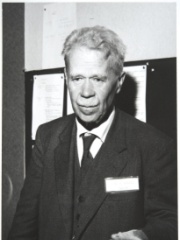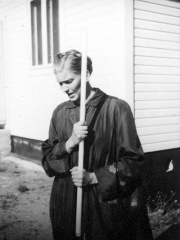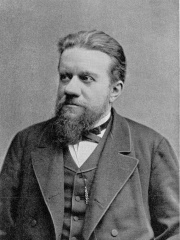



The Most Famous
ASTRONOMERS from Finland
This page contains a list of the greatest Finnish Astronomers. The pantheon dataset contains 644 Astronomers, 4 of which were born in Finland. This makes Finland the birth place of the 23rd most number of Astronomers behind China, and Australia.
Top 4
The following people are considered by Pantheon to be the most legendary Finnish Astronomers of all time. This list of famous Finnish Astronomers is sorted by HPI (Historical Popularity Index), a metric that aggregates information on a biography's online popularity.

1. Yrjö Väisälä (1891 - 1971)
With an HPI of 67.37, Yrjö Väisälä is the most famous Finnish Astronomer. His biography has been translated into 33 different languages on wikipedia.
Yrjö Väisälä (Finnish: [ˈyrjø ˈʋæi̯sælæ] ; 6 September 1891 – 21 July 1971) was a Finnish astronomer and physicist. His main contributions were in the field of optics. He was also active in geodetics, astronomy and optical metrology. He had an affectionate nickname of Wizard of Tuorla (Observatory/Optics laboratory), and a book with the same title in Finnish describes his works. His discoveries include 128 asteroids and 3 comets. His brothers were mathematician Kalle Väisälä (1893–1968) and meteorologist Vilho Väisälä (1889–1969). His daughter Marja Väisälä (1916–2011) was an astronomer and discoverer of minor planets. Väisälä was a fervent supporter of Esperanto, presiding over the Internacia Scienca Asocio Esperantista ("International Association of Esperanto Scientists") in 1968.

2. Liisi Oterma (1915 - 2001)
With an HPI of 66.39, Liisi Oterma is the 2nd most famous Finnish Astronomer. Her biography has been translated into 36 different languages.
Liisi Oterma (Finnish pronunciation: [ˈliːsi ˈotermɑ]; 6 January 1915 – 4 April 2001) was a Finnish astronomer, the first woman to get a Ph.D. degree in astronomy in Finland. She studied mathematics and astronomy at the University of Turku, and soon became Yrjö Väisälä's assistant and worked on the search for minor planets. She obtained her master's degree in 1938. From 1941 to 1965, Oterma worked as an observer at the university's observatory. She obtained her PhD in 1955 with a dissertation on telescope optics. She was the first Finnish woman to obtain a PhD in astronomy. In 1959, Oterma became a docent of astronomy and from 1965 to 1978 a professor in University of Turku. In 1971, she succeeded Väisälä as the director of the Tuorla Observatory. She was director of the astronomical-optical research institute at the University of Turku from 1971-1975. Oterma was interested in languages and spoke German, French, Italian, Spanish, Esperanto, Hungarian, English and also Arabic, for example. Oterma's original plans were to study Sanskrit, but it was not offered at the University of Turku, and the choice was ultimately focused on astronomy. Oterma was quiet, modest in nature, and fearful of publicity. Anders Reiz, a professor at the Copenhagen Observatory, among others, said Oterma was “silent in eleven languages”. Oterma avoided appearing in photographs, and there are only a handful of pictures of her. She discovered or co-discovered several comets, including periodic comets 38P/Stephan-Oterma, 39P/Oterma and 139P/Väisälä–Oterma. She is also credited by the Minor Planet Center (MPC) with the discovery of 54 minor planets between 1938 and 1953, and ranks 153rd on MPC's all-time discovery chart. The Hildian asteroid 1529 Oterma, discovered by Finnish astronomer Yrjö Väisälä in 1938, was named in her honour.

3. Heikki A. Alikoski (1912 - 1997)
With an HPI of 59.05, Heikki A. Alikoski is the 3rd most famous Finnish Astronomer. His biography has been translated into 21 different languages.
Heikki A. Alikoski (1912, in Oulu – 28 December 1997, in Turku) was a Finnish astronomer and discoverer of minor planets. From 1937 to 1956, he was an observatory assistant under Yrjö Väisälä at Turku Observatory, where he discovered 12 asteroids. Alikoski later helped establish the Turku Astronomical–Optical Institute. The outer main-belt asteroid 1567 Alikoski, discovered by Yrjö Väisälä in 1941, was named in his honour.

4. Hugo Gyldén (1841 - 1896)
With an HPI of 56.30, Hugo Gyldén is the 4th most famous Finnish Astronomer. His biography has been translated into 15 different languages.
Johan August Hugo Gyldén (May 29, 1841 in Helsinki – November 9, 1896 in Stockholm) was a Finland-Swedish astronomer primarily known for work in celestial mechanics. Gyldén was the son of Nils Abraham Gyldén, Professor of Classical philology at the University of Helsinki and baroness Beata Sofia Gyldén. He spent his student years at his father's university, graduating as a filosofie magister from the Faculty of Physics and Mathematics in 1860. He studied under Lorenz Leonard Lindelof and then went to do a postdoctoral at Gotha under Peter Hansen working on the orbit of Neptune. In 1871 he was called by the Royal Swedish Academy of Sciences to be its astronomer and head of the Stockholm Observatory. From 1872 he was a member of the Academy. In 1885 he became foreign member of the Royal Netherlands Academy of Arts and Sciences. The lunar crater Gyldén and the minor planet 806 Gyldenia were named in his honor.
People
Pantheon has 4 people classified as Finnish astronomers born between 1841 and 1915. Of these 4, none of them are still alive today. The most famous deceased Finnish astronomers include Yrjö Väisälä, Liisi Oterma, and Heikki A. Alikoski.
Deceased Finnish Astronomers
Go to all RankingsYrjö Väisälä
1891 - 1971
HPI: 67.37
Liisi Oterma
1915 - 2001
HPI: 66.39
Heikki A. Alikoski
1912 - 1997
HPI: 59.05
Hugo Gyldén
1841 - 1896
HPI: 56.30
Overlapping Lives
Which Astronomers were alive at the same time? This visualization shows the lifespans of the 4 most globally memorable Astronomers since 1700.

